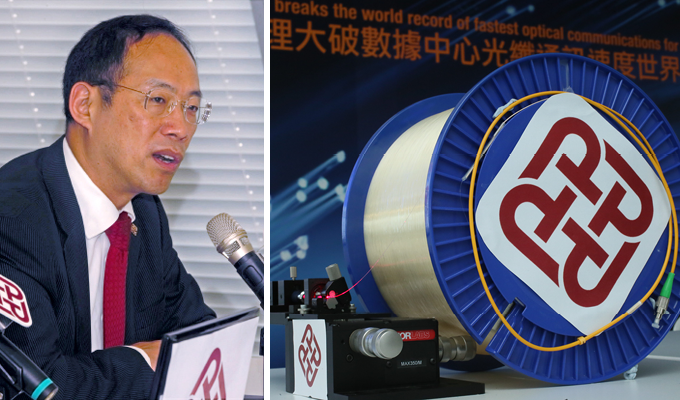In this issue, Prof. Alex Wai, PolyU Vice President (Research Development) and Chair Professor of Optical Communications, introduced the latest optical communications technology developed by the University. The technology has broken the world record of fastest optical communications for data centres.
What challenges are the data centres facing in recent global communications network?
Google, Facebook, YouTube are some widely-known examples of data centres on a global scale. Whenever we do an online search, read a newsfeed on social media platform, stream a video online, or upload a file to the cloud, the traffic goes through data centres. The data centres serve as the backbone of Big Data and Internet of Things (IoT) applications, but on the other hand, these data centres are also the largest obstacles in increasing transmission speed. Low-cost and high speed upgrades for data centre connections are, therefore, needed. However, there is no practical solution in the market, thus creating a major technological challenge that data centres are facing.
How is the current development of optical communications?
In optical communications, all information such as text, sound, music, image and video are digitized and transmitted as light signals over optical fibre. During transmission, light will interact with molecules in the optical fibre through reflection and refraction. The light signal will then change when it arrives at the receiver, making it a distorted signal. The higher the transmission speed and the longer the distance, the more severe is the distortion, rendering the light signal unrecognisable at the receiver. This therefore limits the maximum transmission speed. Currently, specialised hardware, such as specialised optical fibre, is used to undo distortion. However, its high cost and bulky size has made such solution impractical for use in data centres.
What are the breakthroughs of PolyU’s latest optical communications innovation?
With these limitations in mind, Prof. Lu Chao and Dr Zhong Kangping of the Department of Electronic and Information Engineering, Dr Alan Lau of the Department of Electrical Engineering and myself, have partnered with Huawei Technologies Co. Ltd., a leading global information and communications technology solution provider, to develop a software approach to undo signal distortions.
The interaction of light and a single fibre molecule is a known theory in optics. However, billions of molecules in an optical fibre are randomly placed and the overall interaction effect between the light signal and fibre is unpredictable. Therefore, the signal distortion is also random. With our breakthrough, around 10,000 people can simultaneously stream 4K video at less cost, compared to only 400 people under the current available speed.
We also broke the world record of fastest optical communications for data centres by reaching 240Gbit/s over 2km i.e. 24 times of the existing speed available in the market. With the cost per unit of data transmission reduced to just one-fourth of the existing cost, the technology is suitable for commercial use. It realises speedy transmission at a significantly low cost for data centres, thus enabling end-users to widely use new forms of communications such as immersive videos, augmented reality and virtual reality. We believe that increased transmission speed will open up a new era for Big Data and IoT (Internet of Things) applications.
